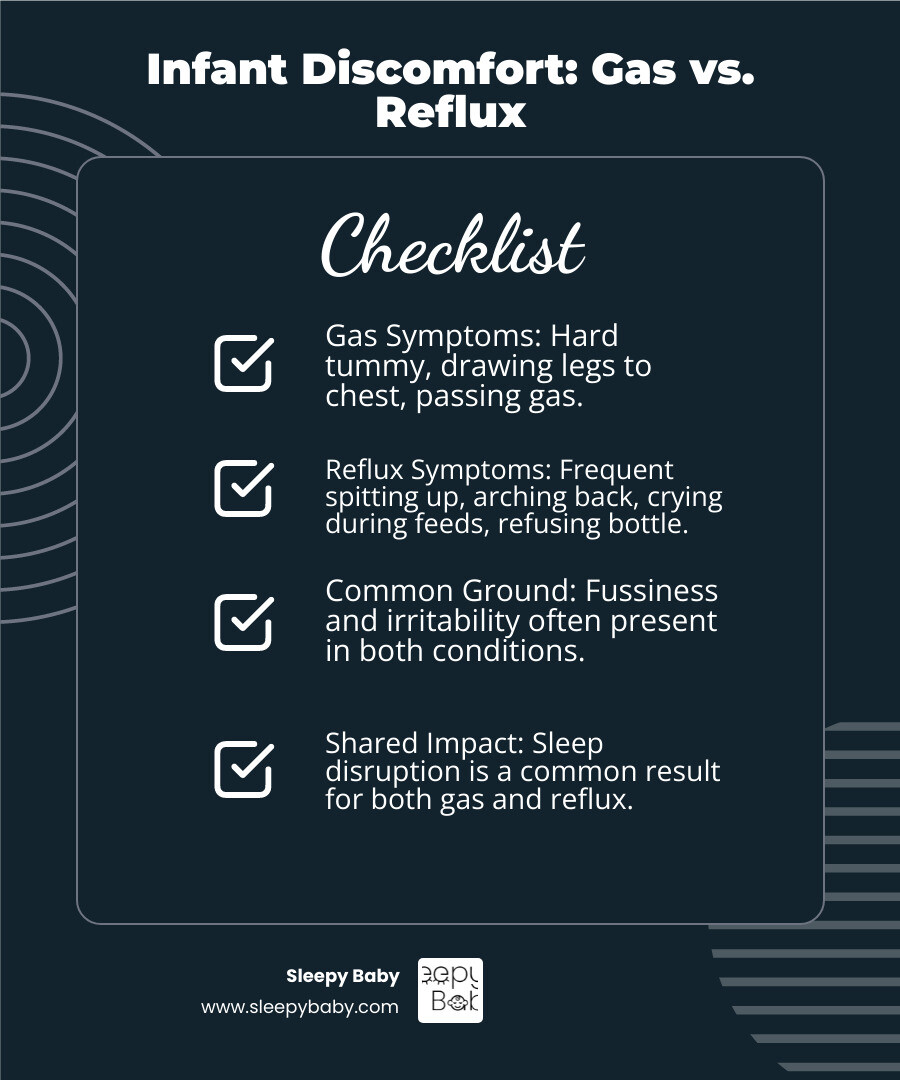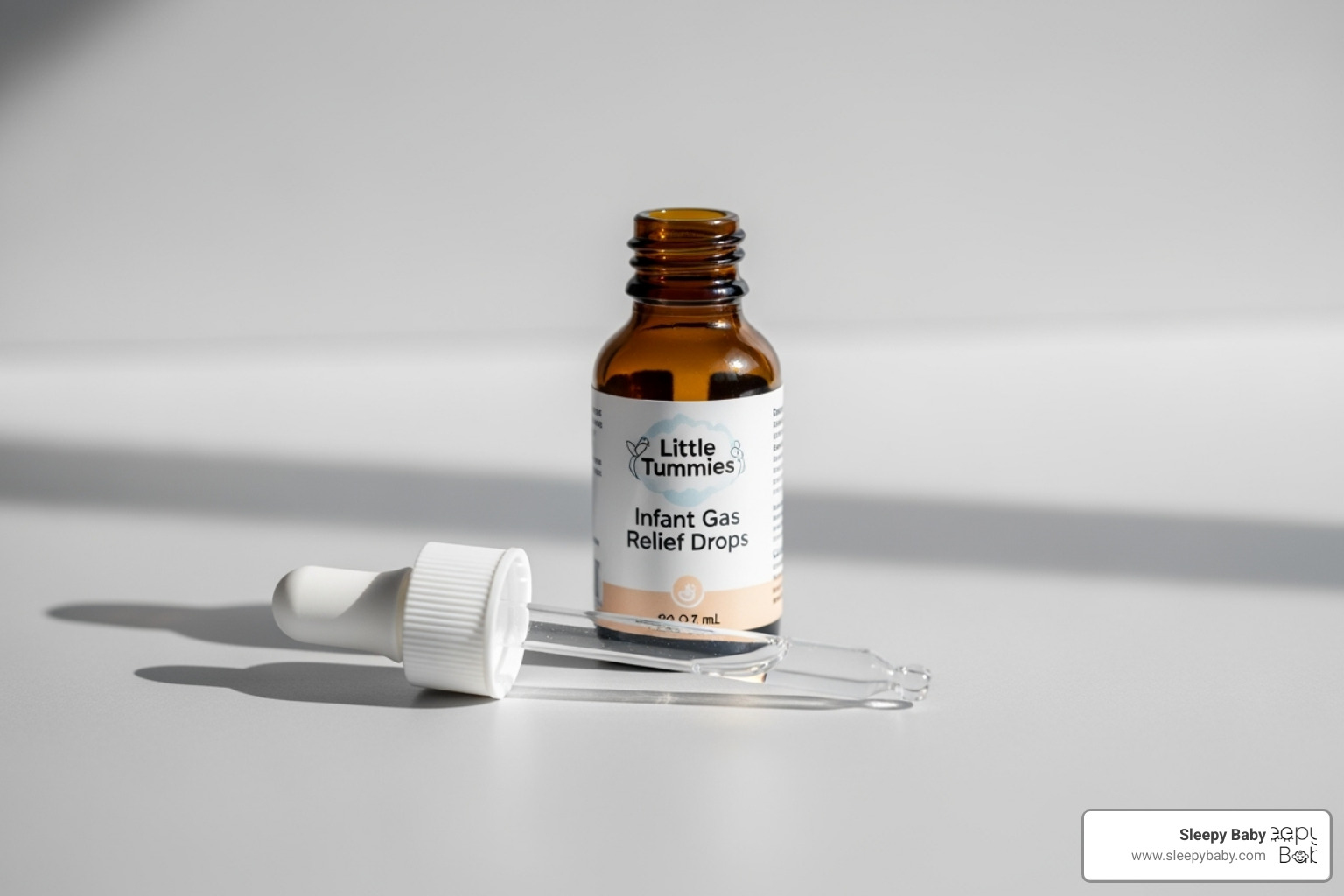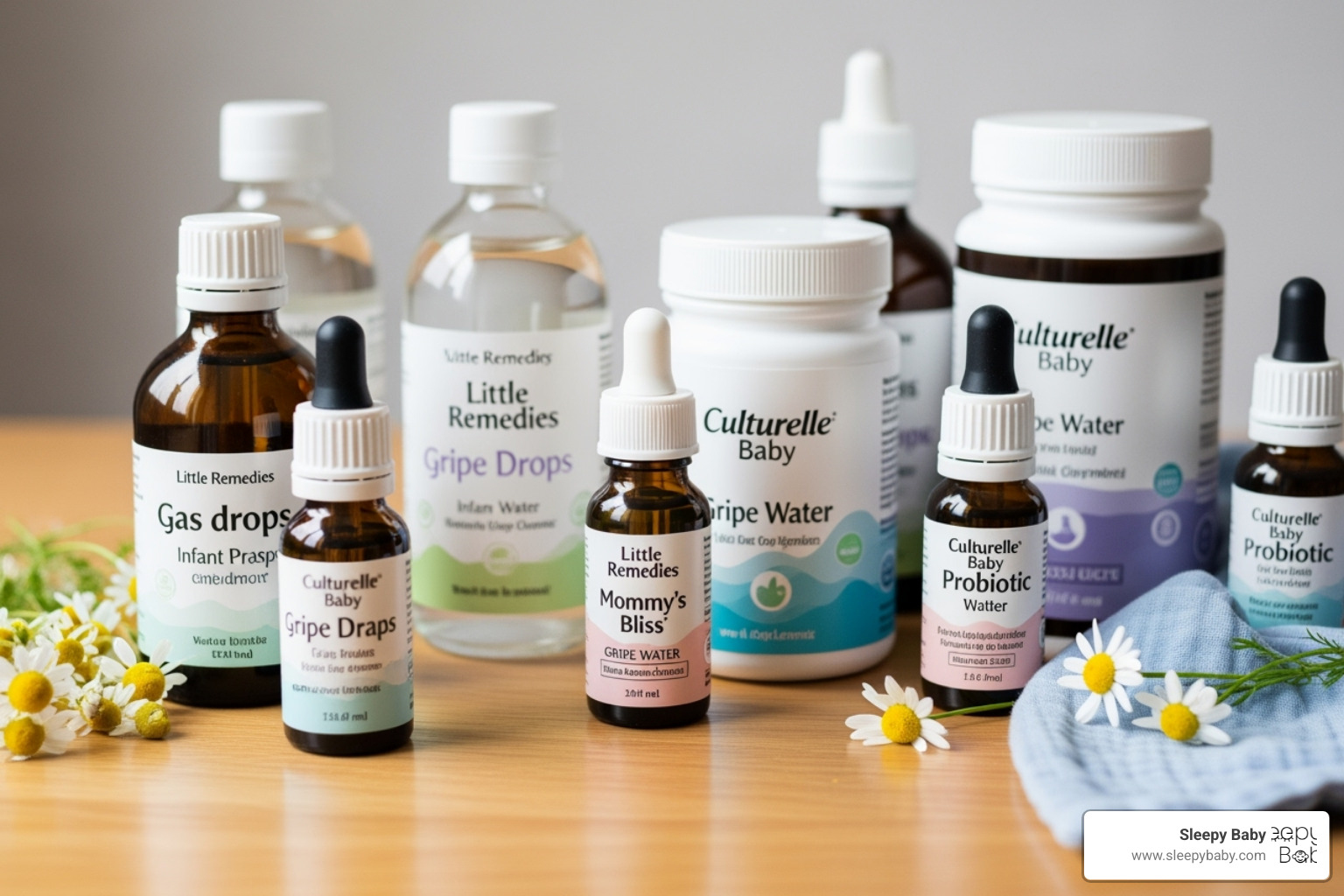Understanding Gas Drops for Infant Reflux Relief
Gas drops for reflux are a common search for parents of fussy, uncomfortable babies. These drops contain simethicone, an ingredient that breaks up gas bubbles in the stomach. While they don't treat reflux itself, they help with the gas symptoms that often accompany it. Pediatricians have recommended them for over 40 years, and they are considered safe for newborns when used as directed. They work in minutes to relieve trapped gas and can be given up to 12 times daily, either directly or mixed with formula.
If you're Googling "Why is my baby crying?" at 3 AM, you're not alone. All babies have some reflux, but when it involves back arching, feeding refusal, and inconsolable crying, it feels like an emergency. The challenge is that reflux and gas symptoms often overlap, making it hard to know what will help. While gas drops won't cure reflux, they can relieve the trapped air that worsens reflux episodes.
I'm Gary Harutyunyan, and as a new father whose baby struggled with digestive discomfort, I researched every solution, including gas drops for reflux relief. My journey led me to create the Sleepy Baby device, and I've learned that effective infant comfort often requires multiple approaches working together.

Decoding the Discomfort: Is It Reflux, Gas, or Both?
Infant discomfort can be a mystery, as reflux and gas symptoms often look remarkably similar. Both can cause fussiness, crying, and disrupted sleep. Gas pressure can even worsen reflux by pushing stomach contents upward. Understanding the cause helps you choose the right approach. Infant gastroesophageal reflux is common because a baby's immature digestive system is still developing. The muscle between the stomach and esophagus is weak, allowing food to come back up. Gas occurs when babies swallow air during feeding or crying. This trapped air causes discomfort until it's released. Relieving gas pressure can also ease reflux discomfort by reducing abdominal pressure. This is why gas drops for reflux relief can be effective, even though they don't treat reflux directly. For more detailed guidance, check out help for babies with reflux and our comprehensive Newborn Gas Relief Guide: Helping Your Little One Feel Better Fast.
What are the common signs of reflux in babies?
Reflux symptoms range from mild "happy spitting" to significant pain. Look for a combination of these signs:
- Frequent spitting up: Especially when accompanied by signs of discomfort.
- Arching the back: A common sign of pain from stomach acid during or after feeds.
- Fussiness during feeding: Pulling away from the breast or bottle, feeding for short periods, or refusing to eat.
- Excessive crying: Intense, difficult-to-soothe crying during or after feeding.
- Poor sleep patterns: Frequent waking or difficulty settling due to discomfort.
How is gas different from reflux?
While reflux is stomach contents coming up, gas is about trapped air causing pain. Gas symptoms are often more straightforward:
- Hard or distended tummy: The belly feels tight and bloated.
- Drawing legs to chest: An instinctive motion to relieve pressure.
- Passing gas: Frequent, forceful, or accompanied by straining and crying.
- Pain at any time: Unlike reflux, which is tied to feedings, gas pain can strike anytime, often in waves.
Understanding these differences helps you choose the right solution. If you see signs of gas, gas drops for reflux and gas relief might be what your baby needs. Learn more in our guide Gas Relief 101: Easing Your Baby's Discomfort.
The Science of Simethicone: How Gas Drops Work

The active ingredient in gas drops for reflux is simethicone. It works by changing the surface tension of gas bubbles in the stomach, causing small, trapped bubbles to merge into larger ones. These larger bubbles are easier for a baby to pass by burping or flatulence, providing quick relief. A key benefit is that simethicone is not absorbed into the bloodstream. It works locally in the digestive tract and passes through the system unchanged. This physical, rather than chemical, action means it doesn't interfere with digestion. Popular brands like Mylicon have been pediatrician-recommended for over 40 years. While results can be seen in minutes, gas drops don't prevent new gas from forming; they only treat existing gas. For a deeper dive, check out How Does Simethicone Work? The Science Behind Gas Relief.
Are gas drops for reflux a safe option for newborns?
Yes, gas drops for reflux are generally considered very safe for newborns when used as directed. Pediatricians have recommended simethicone for decades because it isn't absorbed into the baby's system, minimizing the risk of side effects. Always follow dosage guidelines, typically up to 12 times daily as needed. Side effects are rare but can include mild loose stools. The Mayo Clinic suggests avoiding drops with sodium benzoate or benzoic acid, so check the label. Many formulations are dye-free, alcohol-free, and saccharin-free. It's always best to consult your pediatrician before starting any new medication. The Mayo Clinic Q and A: Gas Drops for Fussiness offers more safety insights.
How should I give my baby gas drops?
Administering gas drops is usually straightforward. Here are a few methods:
- Directly: Use the provided dropper to place the dose inside your baby's cheek while they are in an upright position.
- Mixed in a bottle: Add the drops to a small amount of formula, breast milk, or cool water. Ensure your baby drinks the entire amount to get the full dose.
- Proactively: Giving drops before feedings can help break up gas bubbles as they form, preventing discomfort.
Always shake the bottle well before use and keep the dropper clean. For more tips, see our Step-by-Step Guide to Choosing Effective Infant Gas Drops.
The Role of Gas Drops for Reflux: A Comparison of Remedies
When your baby is suffering from gas or reflux, it can be overwhelming to steer the many available remedies. Gas drops for reflux are just one tool, and understanding how they differ from other options can help you make the best choice for your baby.

Gas drops are a targeted tool for a specific job: breaking down existing gas bubbles for quick relief. Other remedies, like probiotics, take a different approach by focusing on long-term gut health. Often, these methods can be used together. Our article, Baby Gas Drops: What Works for Colic Relief?, digs deeper into these comparisons.
Comparing gas drops for reflux with other popular approaches
Let's compare how gas drops for reflux stack up against another common remedy, probiotics. They work differently and are used for different purposes.
| Feature | Gas Drops (Simethicone) | Probiotics |
|---|---|---|
| Active Ingredient | Simethicone | Live beneficial bacteria (e.g., Lactobacillus reuteri) |
| How it Works | Physically breaks up existing gas bubbles | Biologically restores healthy gut flora over time |
| Speed of Relief | Fast (within minutes) | Slow (days to weeks of consistent use) |
| Best For | Immediate relief from trapped gas and bloating | Long-term digestive health and potentially reducing gas production |
Gas drops provide fast relief for immediate discomfort, while probiotics are a long-term strategy for improving gut health. Many parents use gas drops for acute pain while also giving probiotics for sustained benefits.
What about Probiotics?
Probiotics work differently than gas drops for reflux by aiming to improve gut health over the long term. They introduce beneficial bacteria, like Lactobacillus reuteri, to balance a baby's developing digestive system. This may help reduce gas production and reflux over time. While research shows promise for reducing colic and fussiness, results vary, and it can take weeks to see an effect. Probiotics address potential root causes, whereas gas drops provide immediate symptom relief. Always talk to your pediatrician before starting probiotics to ensure they are right for your baby. For more insights, check out our article Colic Drops: Separating Fact From Fiction.
Beyond the Bottle: Soothing Strategies for Reflux and Gas
While gas drops for reflux provide targeted relief, a holistic approach often works best. Combining medication with gentle soothing techniques can make a significant difference. The key is trying different approaches to find what comforts your baby. For comprehensive guidance, check out our Infant Colic Relief: Tips and Tricks for Exhausted Parents.

Feeding and Positioning Techniques
How you feed your baby can be as important as what you feed them. Small adjustments can provide significant relief from gas and reflux.
- Upright feeding: Keep your baby more vertical during bottle or breastfeeding to help gravity keep milk down and reduce air swallowing.
- Frequent burping: Pause every few minutes during a feeding to burp your baby, rather than waiting until the end.
- Smaller, more frequent feeds: These are easier for an immature digestive system to handle than large meals.
- Keep baby upright after feeds: Hold your baby upright for 20-30 minutes after eating to help with digestion.
- Paced bottle feeding: Use a slow-flow nipple and let your baby control the pace to prevent gulping air.
- Avoid slumping positions: Ensure your baby isn't slumped in a way that compresses their abdomen, as this can worsen reflux.
Comforting and Soothing Your Baby
Beyond feeding, several soothing methods can calm a fussy baby.
- Swaddling: Recreates the snug feeling of the womb. Products like the Halo Sleep Sack can make this easier and safer.
- White Noise: Constant, steady sound can be very calming. While some machines can be too loud, it's important to choose modern, safety-rated white noise devices. These present sound at safe, low-decibel levels and are sometimes designed to be placed on the baby's chest.
- Rhythmic Tapping: The benefits of rhythmic tapping devices, such as our Sleepy Baby, include mimicking a caregiver's soothing touch. This gentle, consistent patting provides hands-free comfort that is particularly effective for babies with gas and reflux.
- Pacifiers: Sucking on a pacifier can be comforting during fussy periods.
- Movement: Gently bicycling your baby's legs or giving them a warm bath can help relax their tummy and release trapped gas.
When to Call the Pediatrician
While gas and reflux are common, contact your pediatrician if you notice any of the following:
- Growth concerns: Poor weight gain or weight loss.
- Signs of dehydration: Fewer wet diapers, lethargy, or a sunken soft spot.
- Forceful vomiting or blood in the stool.
- Consistent refusal to feed.
- Excessive, high-pitched, or unusual crying.
- Fever over 100.4°F (38°C) in an infant.
The American Academy of Pediatrics encourages parents to reach out with any concerns. Trust your instincts.
Frequently Asked Questions about Gas Drops and Reflux
As parents, we have countless questions about gas drops for reflux and gas relief. Here are answers to the most common ones.

Can gas drops make reflux worse?
No, gas drops for reflux are not known to make reflux worse. The active ingredient, simethicone, works physically to break down gas bubbles. It does not affect stomach acid or the muscle that controls reflux. In fact, by relieving gas pressure in the stomach, the drops can actually make reflux episodes less uncomfortable. Reducing this pressure may lessen the force pushing stomach contents upward, easing one source of your baby's discomfort.
How quickly do gas drops work?
Gas drops work fast, with most parents reporting relief for their baby within minutes. Simethicone acts on contact with gas bubbles in the digestive tract and doesn't need to be absorbed into the bloodstream. Drops treat existing gas but don't prevent new gas from forming. This is why they can be given as needed, even before feedings, to manage discomfort. For more insights, explore our guide Quick Comfort: Top Fast-Acting Gas Medicines to the Rescue.
Can I use gas drops and probiotics together?
Yes, you can typically use gas drops for reflux and probiotics together, as they serve different functions. Gas drops offer immediate, physical relief from existing gas, while probiotics work over the long term to build a healthy gut biome. Since simethicone isn't absorbed, it doesn't interfere with the beneficial bacteria. However, always consult your pediatrician before combining remedies. They can offer personalized advice. It's also wise to observe your baby for any reactions when introducing a new combination.
Conclusion
Navigating infant discomfort can be overwhelming. As we've explored, gas drops for reflux are a valuable tool, offering safe, targeted relief for the gas that often accompanies reflux. While they don't cure reflux, they can significantly improve your baby's comfort by breaking down painful gas bubbles quickly and safely.
However, effective infant comfort rarely comes from a single solution. The best approach combines the immediate relief of gas drops with other strategies. This includes thoughtful feeding techniques, proper positioning, and a variety of soothing methods. The gentle rhythm of our Sleepy Baby device, the calm of safe white noise, and simply holding your baby upright after feeds all work together to create a more peaceful experience.
Every baby is unique, so having multiple tools is key. Most importantly, trust your parental instincts. If your baby's discomfort persists or you have any concerns, always contact your pediatrician. With knowledge, the right tools, and a comprehensive approach, you can help your baby move from discomfort to contentment. For more product reviews, explore our article on Relief in a Drop: Top Infant Gas Drops Reviewed.




